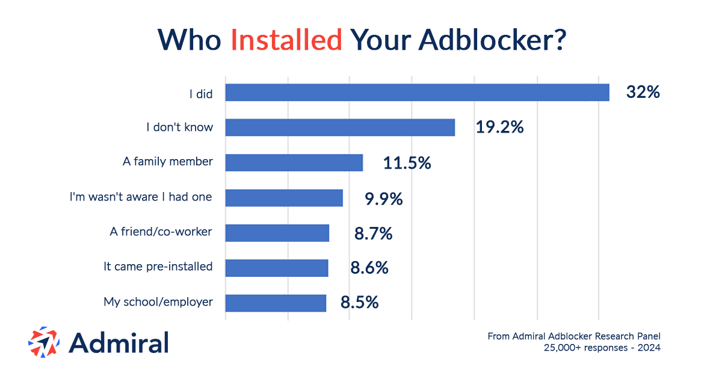Retro spoiler alert: “Soylent Green is People!”
That final line of the 1963 film became iconic and is still listed in most top movie quotes lists. It was a revelation, a kept secret despite a society where every man woman, and child knew of the Soylent Green brand, but not the ingredients.
Similarly, the adtech industry is being disrupted by adblock technology that empowers people to have more choices over their web experience and personal data. People are not unidimensional eyeballs, a homogeneous ‘audience’, or mere stats to track.
Nothing has made that more prevalent than the growth of adblock technology and the demands of users for greater privacy and control. Not only was there a wave of adblocking technology, but as anti-adblock detection grew, there were developments of the anti-adblock killer.
For the digital ad industry, this is a large and growing problem. Digital Information World reports research from the Global Web Index that 47% of internet users use adblocking technology today, and Digiday reports that the cost to publishers could exceed $35 billion by 2020. So what should publishers and brands keep in mind about the diverse preferences of their visitors and the need for nimble visitor relationship solutions?
Reasons for using adblocking technology vary greatly among internet users:
The Unaware Adblocker
An Admiral survey of over 25000 adblock users reported that 68% did not personally install or turn on their adblocking software. 19% didn’t know who installed it, and 10% didn’t even know they had adblocking software running.

Their browser might default to a privacy mode that disrupts ads, and they may not be aware or know how to block adblock. This is a growing concern with the Firefox decision to turn on enhanced ad tracking blockers as the default for millions of users.
- Takeaway: Publishers should not assume that adblocker users made a conscience choice, or that they dislike seeing good ads. This group is more open to allowlist your website if they are shown a quick and easy way to accomplish it.
Desire for Greater Online Privacy
Some users have turned to adblockers to have more control and online privacy. It’s not necessarily the ads they are concerned about, but the amount of information that is shared about their internet behavior across the web.
- Takeaway: This group is less likely to block ads if they are given the option to control the experience. They are more open to whitelisting a site they trust if given the option. Make it easy to whitelist your website, and provide content that addresses trust and privacy concerns, as well as link to how to disable adblock extensions. Admiral has created a megalist with screenshots showing users how to disable adblock and whitelist publisher sites.
It’s Not Ads, it’s the Ad Experience!
Data from the Global Web Index study reports that over 40% of the respondents were concerned about too many, intrusive, or irrelevant ads on websites they visit. ThinkWithGoogle data reports that 63% installed an adblocker or adblock browser extension because of too many ads.
- Takeaway - Most adblocker users are not zealots against the idea of digital advertising entirely. Some are asking for a better ad experience. According to Hubspot research, 68% of adblockers are willing to view ads “if they are not annoying”.
Publishers should consider testing offers and options with their visitors to find out what level of engagement or ad experience they prefer. Options include but are certainly not limited to paid subscriptions to ad-free content, sponsored ad-free passes, ad-lite options, email or social sign-ups, and more. Publishers should review and improve the overall ad experience to avoid pushing more visitors to adopt adblocking.
Growing Visitor Relationships
Maximizing and finding alternate methods of driving revenue continues to be a priority for publishers. Painting all visitors, or even all adblock users, with a broad brush will almost certainly miss opportunities. People are not clones, they have diverse needs and choices. They want control and options. Publishers that have a blend of tools to engage visitors will have a stickier site, greater revenue, and be more valued by visitors.
At Admiral, we recognized there was a conflict with the traditional publisher-visitor ad model. Visitors have discreet priorities, as do publishers and brands, and a platform was needed to help provide more innovative and effective solutions for engagement. The Admiral Visitor Relationship Management (VRM) Platform was created to address these diverse needs, making it quick and easy for a publisher to address:
- Whitelist-based adblock recovery and anti ad block
- Custom ad-lite experiences
- Email or social growth via subscription management
- Unique offers such as brand-sponsored ad-free passes
- Privacy consent
- Per-site, per-content piece, and multi-site digital subscriptions
- Testing innovative offers and pricing tailored to visitor segments
Visitors are people, treat them as such and their loyalty will become your competitive advantage. For more information about ad block recovery best practices, see our comprehensive guide for adblock revenue recovery.
Request a demo to learn more about how Admiral’s Visitor Relationship Management (VRM) platform expands the relationship between publishers and users beyond the one-dimensional eyeballs & ads model.





